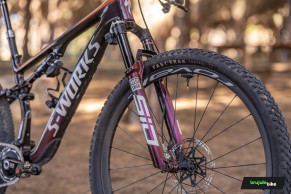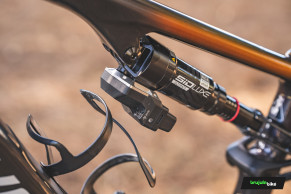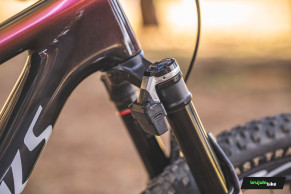We thoroughly tested the RockShox SID Flight Attendant system: it is not essential, but it is difficult to give up on it once you try it
One of the most important presentations of 2024 has been starred by Rock Shox and the Flight Attendant electronic suspension system for XC. A true revolution for mountain biking that we have been testing for a while and now we tell you everything about this technology that is here to change everything.

Rock Shox Flight Attendant: just worry about pedaling
A couple of years ago, Rock Shox launched this technology that, initially was limited to Gravity modalities, but at that time we already saw great possibilities for it to spread to Cross Country competition bikes.
In this time where electronics are well established in the transmission section, it was only a matter of time before it reached the suspensions, and here it makes even more sense, since, for now, in the management of gear changes we are still the ones who decide when to make them and carry out the action, but in the suspensions it can completely free us from thinking and taking any action, and this, when we talk about competition, is a very important change.
RECOMENDADO

What would you do if you won the lottery? This cyclist bought himself a €20,000 bike

The best exercise routine to do at home

Benefits of training in the cold

The cyclist's patience: how long, gentle training sessions build your best season

Tips for cycling in the rain

25 cycling gifts ideas to get it right
The Flight Attendant system is integrated into the Sram AXS ecosystem. So it uses the same batteries that are used for the rear derailleur or the Reverb telescopic seatpost, and all the components are also linked, which we will customize through the Sram AXS App.

Simplifying the concept, we will say that the system manages the three compression positions that both the fork and the shock absorber have, and it does so autonomously without us having to intervene or decide anything. The "how" it does it is the ingenious and sophisticated part of the system.
Aside from the left remote control, with which we can control some options, as we will explain, we have three components that communicate with each other, which are the fork, the shock absorber, and the sensor located in the potentiometer. The brain of the system is found in the unit we find in the fork and it records the data provided by the other components.
Thus, based on the readings that the suspensions make of the terrain and the data of our pedaling, the system decides what is the best configuration for the fork and shock absorber.
A couple of years ago we already tested the Flight Attendant when it came out for Trail and Enduro versions, but this new version offers an important novelty. In the previous version, in the crankset we had a cadence sensor to, depending on whether we are pedaling or not, orient the system more towards firmness or sensitivity. In this new version, what comes into play is a potentiometer, specifically the Sram AXS potentiometer, which communicates with the system's brain and this evaluates not only if we are pedaling, but also takes into account at what effort level, and, according to this, it will orient the system more in one direction or another.

This sounds very good but it is not the same for an amateur to pedal or for Nino Schurter to pedal. How does the system know that we are making a big effort or a light one? Well, here comes one of the most striking details of the Flight Attendant. The system records data from your last rides and learns from you. Rock Shox calls it Adaptive Ride Dynamics, and according to them it saves the power data you develop in the last 8 rides. With this data, it configures four effort levels: Low, Medium, High, and Sprint, and always takes into account the effort level we are at each moment to assess the optimal adjustment of the suspensions.
System setup
The Flight Attendant offers a very high level of customization, as we will tell you later, but to start using it we only need to adjust our suspensions, as we would on any other bike, and do a very simple system calibration that will take us a few seconds and is perfectly explained, both in the AXS App and on the Sram website.
In the unit we find at the head of the fork we have three buttons and some LEDs that give us information.
To adjust the sag the only precaution we have to take is to make sure that both suspensions are in open mode. To do this, we hold down the central button until the illuminated LED is red, this indicates that the system is in manual mode and that we can choose any of the three compression positions using the + and - buttons on the fork or also from the remote control. Then we choose the open mode and adjust pressures and rebound of both suspensions as if it were any other bike.
Once this adjustment is done, we follow the simple steps indicated for calibration and we would be ready to go out and ride.

With the system in automatic mode, we will see one or two of the central LEDs illuminated in green indicating the current compression position, and the lower LEDs indicating the effort level. So we would be able to use the bike without needing to do anything else, and it will adapt to the conditions to decide the optimal adjustment of each suspension.
If only one green LED lights up it indicates that both suspensions are in the same position, but there are moments when the system decides to put one less compression point in the fork than in the shock absorber. In this case, we will see two LEDs lit up.
The lower LEDs go through four colors depending on the effort level we are pedaling with. Blue for the lowest level, green for the intermediate, red for high level, and yellow when we reach the sprint level.
In these first rides, the Flight Attendant will not yet be tuned to 100% to our effort levels, but as the days go by, it will learn from us to adjust the four effort levels according to our capacity.
Flight Attendant offers infinite customization
If we take some time to get to know the settings offered by the system, we can adapt the Flight Attendant completely to our personal preferences.
One of the basic adjustments is Bias, or bias adjustment. This adjustment makes the system have more tendency towards open positions, favoring sensitivity and comfort, or towards lockout, favoring efficiency. It consists of 5 levels.

With a short press on the central button of the main unit, one or more LEDs will light up in magenta. If only the central LED lights up, it means that the intermediate setting is selected. By pressing the - button we can light up one or two more LEDs to the left, orienting the system one or two steps towards the open positions. Conversely, with the + button we can move the LEDs towards the tendency to be more closed. There are a total of 5 adjustment positions.
The system could work without the remote control, but thanks to it we have functions like the Override mode. This mode is nothing more than a preferred position that we can have and with a single press on the remote control it activates. When we use it, the LED lights up in orange. A new press makes us return to automatic mode. We can configure through the App that the Override mode is the one we want. By default, it is configured in lockout mode.
Using the App we can modify many more things. For example, we have the option to disable the lockout of both suspensions in automatic mode, or disable only the fork lockout. This way we can use the system in automatic mode knowing that we have the lockout possibility by pressing the remote control to activate the Override mode.

Another option offered by the AXS App is to manually adjust the effort levels. At first, it may seem illogical, since the system learns from us and adapts to our level, but once we have used the system enough and have reached the perfect adjustment for us, we can leave it fixed and, for example, if we have a recovery week with gentle rides, the effort values will not change and will remain optimal for race days.
As we can see, the Flight Attendant offers many customization options so that each user, whatever their preferences, finds the behavior they are looking for.
On the go
The bike we tested has been the new Specialized Epic 8 S-Works, which was presented at the same time as the Rock Shox system.
We have done many kilometers and tested all the options. We even had it in manual mode for several days, making the adjustment changes with the remote control. We did this to test the bike, but it doesn't make much sense to have a system like the Flight Attendant and not take advantage of it, so once we made our checks, we enjoyed the automatic mode and forgot about the suspensions.

At first, it is difficult not to be aware of what the system is doing. Although we try to avoid it, in the first rides our eyes went to the LEDs every now and then to see the position of the suspensions, even more so when we heard that characteristic sound with each mode change. The sound is similar to the one emitted by a Sram AXS rear derailleur, although slightly louder. This is dangerous, as we do not always see the LEDs at first glance, as they light up intermittently with a somewhat slow frequency, and if they are not lit when we look, we have to look away if we don't want to be surprised.
But after the necessary adaptation, we began to trust the system to focus on the great advantage it offers, which is being able to focus our attention on driving and only intervene in maintaining the correct gear in each section.
It is amazing how it seems that the Flight Attendant is guessing the terrain ahead of us. In a matter of milliseconds, it adapts to the situation and we never get the surprise that it does not absorb an obstacle correctly because it is locked when it shouldn't be.
In those less clear situations, where we could well ride open or in the intermediate mode for example, the bias adjustment we have set comes into play. There is a fairly clear difference between the settings at each extreme, but that does not mean that in a clear situation of pushing on firm ground it will not lock, or that in a rough descent it will not fully open the suspensions. It is more about those intermediate situations, where depending on the adjustment we make, we favor one tendency or the other.
However, after many kilometers of testing, the intermediate position has seemed very appropriate to us, practically doing what we would do at all times.
An important detail to consider is that this bias adjustment can be made on the go, not in a compromised area of course, but a couple of button presses on the fork can change it. And this can be a help if we are tired of the back or hands after many kilometers, so we could finish a race or demanding route more comfortably if we move it towards the more open tendency.

It has been a good season that we have been testing the Flight Attendant system and, although the grade we give it is a clear outstanding, there are some details that we liked less.
It is true that once everything is adjusted and adapted to the system the LEDs are not very necessary, and even, through the App, you can opt for dark mode and you don't even have them as a distraction. But if they are there, we would like them to be more functional and, even if it involves more battery consumption, it would be good if they were always on, and even if they adapted to the ambient light, because although indoors they illuminate a lot, in sunny outdoor it is very difficult to see them instantly.
There are some situations where they may be more necessary, for example if we use the Override mode a lot, there will be moments of doubt when we do not know if we have it active or not, and it would be good if we could see it instantly.
Regarding the battery life, according to Sram it is between 20 or 30 hours and, according to our tests, those data are not far off. We have charged each battery several times, but it is not something that becomes tedious as there are several routes that we do without worrying about the issue.
In case of forgetfulness and they reach a very low level, they would enter safe mode and the suspensions would remain in open mode to be able to finish the route.
Conclusions
After this time of use, we can only say that we have gotten used to the good things. It is a greater help than it may seem that the suspensions manage themselves. Not only can we pay more attention to driving, but the system makes many more mode changes than we would make.
On a bike with manual control, we do not usually lock unless there is a section ahead of a certain length that makes the gesture worthwhile, or that we are going to stand up for example. But the Flight Attendant changes mode at any time it will be an advantage. Also, when we are already tired, we do not manipulate the suspensions so much, but the Flight Attendant does not understand fatigue and from the first kilometer to the last it works at the same level.
On the other hand, although perhaps less important, there is the fact that we eliminate two cables from the bike, gaining in aesthetics and simplicity.

It is clear that the Rock Shox Flight Attendant suspensions represent a great investment and, for now, we will only see them on the most exclusive bikes. You have to pay a price for a system that is not essential, but we have no doubt that, to a greater or lesser extent, they make us faster, so it is not surprising that it will end up spreading even more in competition bikes.
At the moment there are already more than a dozen models that include this system as standard, but in addition, on the Rock Shox website you can check if your bike is compatible with the upgrade and purchase it separately.
In this case the prices are as follows:
- The SID SL Ultimate Flight Attendant fork costs 1499€, is offered in 100 and 110mm travel and weighs 1480 grams.
- The SID Ultimate Flight Attendant, with 35mm bars, costs 1599€. It is available in 110 and 120mm travel and weighs 1624 grams.
- The SIDLuxe Ultimate Flight Attendant shock costs €949, is offered in a variety of size and stroke options, and advertises a weight of 349 grams.
The system should be completed with one of the power meters from the Sram AXS range and, optionally, but highly recommended, a Sram Pod AXS controller.